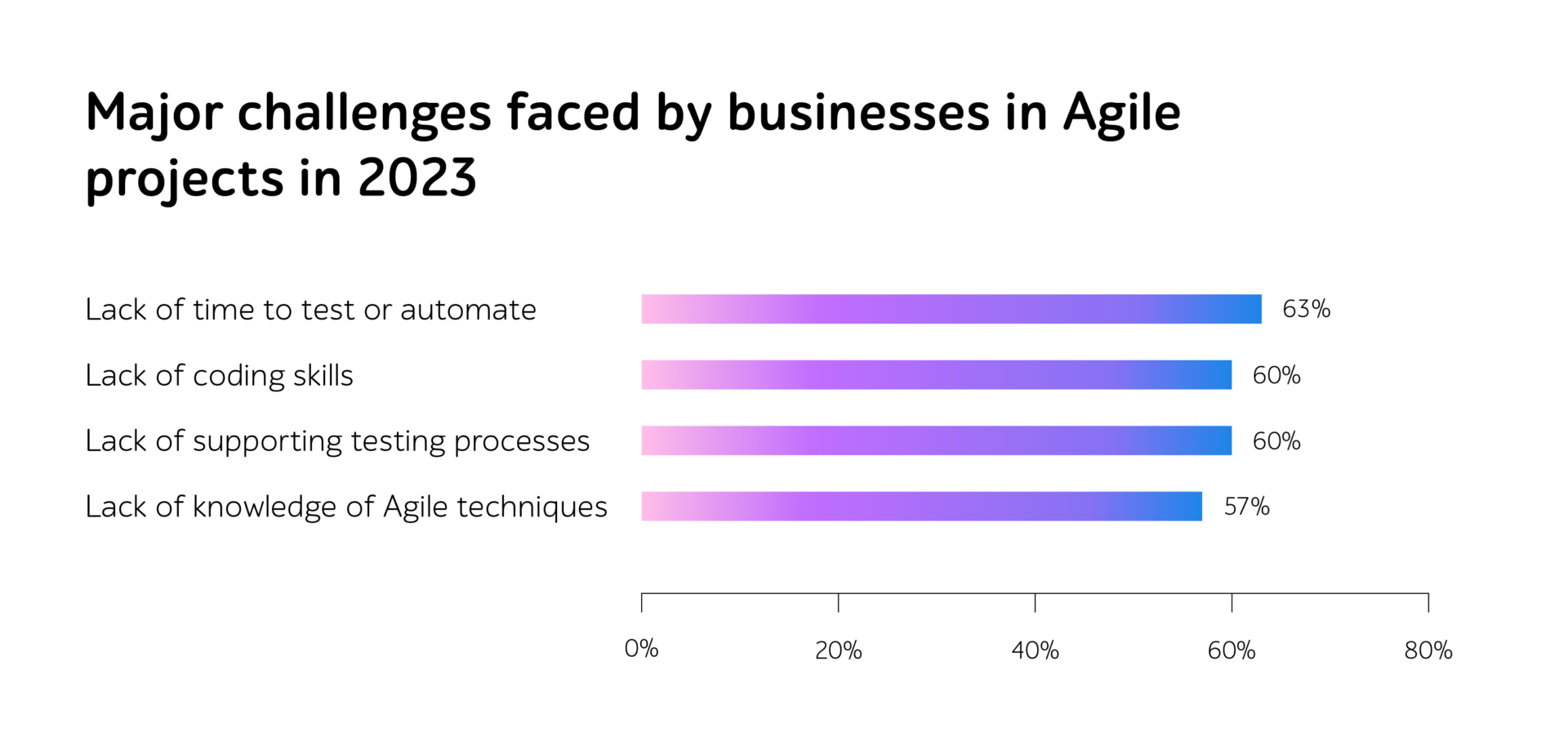
Navigating the future: QA trends that will define 2024. Part 1
Whether your business is navigating cost-saving endeavors, striving to generate more revenue, or on the brink of a transformative pivot, the role of QA is paramount to achieve these results.
By employing software testing trends that will shape this year, companies can tailor their unique pathways and efficiently attain the desired goals.
Let’s get to the point!
Trend #1. Shift beyond traditional test automation to maximize the benefits
By reducing costs, streamlining testing efforts, and improving accuracy, test automation has become a cornerstone in modern software development and QA processes. Moreover, the respondents of the World Quality Report (WQR) 2023-24 state that with automation 54% of them mitigated risks, 52% — enhanced test efficiency, and 51% — decreased the number of live defects in the previous year.
By leveraging test automation, businesses can rapidly execute repetitive and monotonous tests, thus saving hours of manual effort. This accelerates QA workflows, allowing for faster releases of high-quality software and rapid adaptation to changing market demands.
While traditional test automation brings plenty of benefits to the table, companies can maximize them by implementing additional toolsets, namely AI-based and low code/no code.
With AI-driven test automation, organizations have a possibility to:
- Enhance software testing processes. By leveraging machine learning algorithms, AI-based automation identifies complex patterns of IT solutions’ behavior and can predict potential defects at the initial SDLC stages.
- Refine test maintenance. AI-powered automation can adapt to changes in the software and adjust test scripts as the IT product evolves. This capability aids businesses to reduce the labor hours required by QA experts for script updates, ensuring that the testing process remains efficient in the face of continuous development and modifications.
- Optimize test execution. By intelligently selecting and prioritizing tests based on several factors, like code changes and historical defect data, AI algorithms streamline test case execution. Thus, companies speed up test runs, focus on high-impact areas, and pay attention to the weakest parts of the software. This approach makes it possible to identify bugs early in the SDLC, contributing to faster releases and shorter time-to-market.
Although AI-driven test automation holds tremendous potential in revolutionizing QA workflows with enhanced speed and efficiency, there are notable nuances to consider. For example, AI models require ongoing monitoring and refinement to adapt to evolving software changes. In addition, implementing AI-empowered automation involves significant upfront costs related to infrastructure, training, and tool adoption.
Low code test automation provides organizations with:
- Simplified project start. Low code/no code automation provides a streamlined starting point for projects, allowing teams with diverse skillsets to seamlessly introduce test automation. This accessibility facilitates a smoother onboarding process, accelerating the integration of automated testing into projects without the barriers posed by complex coding requirements. Moreover, its out-of-the-box structure simplifies test creation and execution, reducing the time and efforts required to initiate and manage QA activities.
- Accelerated test script development. With no code/low code automation at the core, businesses can create and execute test scripts without the need for extensive programming skills. This speeds up their writing, allowing teams to faster respond to changing requirements and tight deadlines.
Low code automation still requires QA automation specialists to assist from a technical perspective, including the execution framework support. In contrast to traditional test automation solutions built on open-source free toolsets, codeless tools often come with a price tag, potentially offsetting the perceived budget savings.
By adopting modern test automation methods in 2024, organizations will be able to launch a high-quality IT product at speed while meeting (or even exceeding) end-user needs, reducing operational expenditure, and minimizing risks. However, to attain these goals, companies should carefully consider both the advantages and challenges associated with evolving testing approaches and align them with the specific requirements of the project.
Trend #2. Continue embracing Agile practices to strengthen competitive edge
A staggering 80% of companies worldwide are now leveraging Agile practices. The driving force behind this surge lies in the business benefits it brings, with 52% of respondents accelerating time to market and 31% mitigating risks through Agile implementation.
However, this transformative journey isn’t without its challenges. A significant hurdle for many organizations is a skill gap: 60% of the 1,750 IT executives interviewed for WQR grappled with a lack of coding abilities and 57% of them faced a lack of knowledge of Agile techniques.

Source: World Quality Report 2023-24
To address these issues, companies should:
- Invest in training programs to empower QA teams with the right skillset, enhance their coding competences, and improve their ability to effectively contribute to Agile processes.
- Introduce a shift-left testing approach to identify and rectify software bugs at the nascent SDLC stages, thereby eliminating expensive post-launch defect fixes and refining the overall IT products’ quality.
- Integrate with DevOps/DevSecOps to foster a seamless CI/CD pipeline, execute automated test scripts on different environments, ensuring faster delivery of reliable applications and the adoption of security practices throughout the entire software development lifecycle.
Trend #3. Prioritize value over speed to drive strategic business outcomes
Since many companies are already moving at a fast pace, their priorities have shifted from speed to identifying risks and minimizing them, maintaining financial stability, and securing organizational reputation.
To shift towards a result-oriented mindset and focus on client-centricity, 71% of companies incorporated value stream mapping (VMS) in 2023, as per WQR 2023-24. This approach helps analyze, streamline, and optimize business workflows (from initial idea to final software launch) to boost customer experience.
In part 2 of the article, we’ll explore more QA and software testing trends, helping you attain the desired business objectives in 2024. Stay tuned!
To get professional QA assistance in enhancing your software quality, reach out to a1qa’s team.








